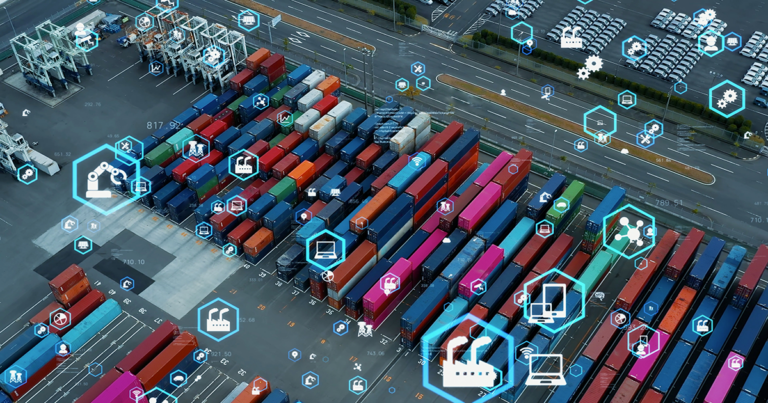The digitalization of transport: towards better traceability of goods
In a context where supply chains are facing security, political, economic and environmental challenges, shippers are expressing a growing need for traceability and real-time visibility on their flows. Delivery delays, administrative burdens and risk management hinder the fluidity of exchanges. Through the integration of advanced digital tools, carriers and logisticians streamline shipments tracking, reduce costs, and strengthen supply chains.
According to research firm Fortune Business Insights, the global digital logistics market is expected to reach around USD 120 billion by 2032, up from a valuation of USD 32.44 billion in 2024. This projection, which is based on a compound annual growth rate (CAGR) of 18.1% over the period, illustrates an overall trend related to the increased adoption of digital solutions in the transportation sector.

Towards better traceability of goods
Artificial Intelligence (AI), the Internet of Things (IoT) and blockchain are all tools that are increasingly integrated into logistics and contribute to better tracking of goods.
This sustained integration responds to several challenges in the sector. According to data from Becker Logistics, cargo theft increased by 57% year-on-year in 2023, resulting in losses amounting to nearly USD 130 million. The integration of IoT into infrastructures such as smart containers or other transport equipment is a lever that can automate transits, reduce losses and ensure real-time monitoring of goods.
In 2024, the IT services company, Infosys, revealed that more than 80% of logistics companies worldwide have begun their transition to generative AI. MSC, one of the world’s leading companies in this sector, stands out in particular for its digitised services. In February 2025, the group announced the launch of iReefer, a remote tracking solution designed to offer customers direct access to various information related to their goods (position, temperature, humidity, etc.).
This approach is also advocated in Africa by Africa Global Logistics (AGL), a company acquired by MSC in 2023. “With Live, we offer our customers complete visibility of their shipments, regardless of the mode of transport. Thanks to an intuitive interface, alerts in the event of an anomaly and reliable arrival estimates, they gain reassurance and efficiency. By integrating IoT sensors and CSR indicators, we are making traceability a strategic lever for more sustainable and secure logistics. “,
says Nathalie PONNIAH, Live Project Manager at AGL.
Digitalization of customs procedures: a lever for fluidity
At the same time, the digitalization of customs procedures plays a key role in accelerating cross-border flows. Adopting systems such as the electronic single window, automated declarations, and pre-clearance platforms helps reduce processing times, reduce human error, and increase transparency. According to the World Customs Organization (WCO), more than 70% of customs administrations worldwide have started their digital transformation, with convincing results in reducing transit times and fighting fraud. In Africa, several countries such as Kenya, Ghana and Senegal have adopted digital customs clearance platforms.
“With its Drive 2030 program, AGL is modernizing its systems to provide complete visibility into goods, regardless of mode of transport or destination. This transformation is based in particular on the dematerialization of documents, the automation of formalities and a direct connection with local administrations, allowing accelerated customs clearance, streamlined controls and reinforced compliance at each stage of transit. ” says Sébastien Beuque, CEO – Drive 2030.
These initiatives, supported by ECOWAS and the AfCFTA, reduce delays, limit errors and strengthen coordination between operators and authorities.
Smart warehouses: towards predictive logistics
But digitalization is not limited to the optimization of transport. It creates value across the entire supply chain. The development of smart warehouses illustrates this evolution: based on automation, robotization and predictive analysis, they allow optimized inventory management and increased security of operations. In Africa, pilot projects in Abidjan, Lagos, and Nairobi are integrating technologies such as autonomous mobile robots and RFID systems to meet the growing demands of the market.
“In South Africa, AGL manages a 14,000 m² smart warehouse equipped with automated guided vehicles (AGVs) for a world leader in telecommunications equipment, illustrating its ability to offer automated solutions, adapted to the needs of various sectors – technology, agribusiness, distribution or commodities – and to African realities,” says Sébastien Beuque, CEO – Drive 2030. »
Cybersecurity, high costs and interoperability
In its report, UNECE identifies several obstacles to the successful integration of digital technologies in the world of logistics, including cybersecurity. As the digitalization of supply chains intensifies, the protection of sensitive data is of particular importance, due to the risk of cyberattacks.
In addition, the high costs associated with implementing digital projects and the lack of interoperability between digital logistics platforms are all challenges to consider, according to the document.
Faced with these challenges, UNOCE calls for a greater role on the part of governments, in particular for the establishment of regulatory frameworks for data protection in the sector, as well as appropriate policies to support projects. For its part, Minterminds, the software solutions developer, invites the various stakeholders, in particular logistics companies, to adopt a rigorous strategy in order to remove the various obstacles mentioned.
Digitalization is profoundly transforming supply chains, bringing gains in performance, safety and sustainability at every stage of transport. By integrating advanced technologies into its operations—from intelligent goods tracking to automated warehouse management to simplifying customs procedures—it is transforming supply chains in Africa and beyond.
